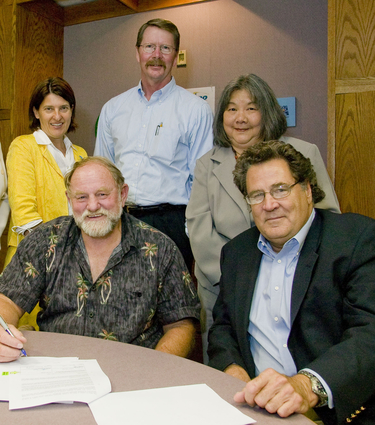Hawaiian nonprofit organization to utilize LLNL energy technologies for food production
LIVERMORE, Calif. — Next year, a nonprofit organization hopes to begin processing tropical foods on the island of Hawaii with the aid of two energy technologies developed by Lawrence Livermore National Laboratory (LLNL) scientists.
This vision was advanced last week as Mike Gleason, the president and CEO of The Arc of Hilo, inked a memorandum of understanding with LLNL Director George Miller had already signed the document on behalf of the Laboratory.
Based in Hilo, Hawaii, The Arc of Hilo has leased an 18,000-square-foot warehouse to provide a location where local farmers can develop higher-value food products, such as fruit leather, jams and natural sweeteners, Gleason said.
Founded in 1954, The Arc of Hilo offers a wide range of services to people with disabilities, including employment training and job placement, and seeks to create additional jobs in the community for people with disabilities.
The Livermore energy technologies — a new advance for harnessing solar energy and another for storing and retrieving electrical power — would be used to provide electricity for the food processing facility.
"We strongly embrace this relationship with the Arc of Hilo as the latest example of LLNL's long commitment to education, research and public service in the Pacific region," Miller said.
"We think working with the Lab and these technologies are a tremendous fit," Gleason said. "It will allow us to create these job opportunities with much lower energy consumption. "We are looking at these cutting-edge technologies as being the first step in bringing training and jobs related to sustainable and innovative advances to our community."
It is hoped that the plant's electrical bills could be reduced by 50 percent, Gleason said, noting that the seven-island state has some of the higher electricity rates in the nation.
"Our building will be 'green' from three different points of view," Gleason observed. "First, it will recycle the layout and some equipment, such as a flash freezer, and cooling and drying rooms from the old food processing enterprise of the owner, Ernie Matsumura. Second, it will integrate LLNL's solar thermal and electromechanical battery technology into the food processing scheme, where each technology is at its best. And third, modifications to the building will be developed with reference to the Leadership in Energy and Environmental Design (LEED) construction standards."
Annemarie Meike, the LLNL business development executive who has catalyzed and developed the business partnerships, noted: "We are excited by the potential of helping to make some of Mike's vision a reality with LLNL technologies, and thankful to Ernie for recognizing our common interests and introducing us."
Two Northern California start-up businesses, Amber Kinetics of Fremont and Tassajara Technologies of Livermore, are in the process of licensing the LLNL technologies.
Amber Kinetics is licensing the electromechanical battery/flywheel and electrostatic (ES) generator/motor technologies, while Tassajara Technologies is licensing the solar energy advance.
The LLNL flywheel battery, developed by Dick Post, is a high-tech version of an ancient concept: using a rotating wheel to store kinetic energy, as in a potter's wheel. In this case, the energy is stored in a rotor made of a high tech fiber material that spins above a magnetic bearing at about 40,000 to 50,000 revolutions per minute. The flywheel is used for the bulk storage of electricity.
Post's complement to the flywheel, an ES generator/motor is useful for generating electricity. A new configuration of the ES generator/motor has been developed and its performance has been validated by computer simulation.
The LLNL solar thermal technology, developed by Charles Bennett, can supply electric power for six cents per kilowatt hour at the single family residential scale, and is lower than the current retail price for residential electric power of about 10 cents per kilowatt hour.
About 25 percent of the incident sunlight in the LLNL system is converted to electric power, with most of the remaining solar energy captured for water heating or space heating. In winter, about 90 percent of the incident sunlight is exploited.
The building of the technology prototypes is funded in part by a novel "grassroots" maturation scheme for clean technology rolled out this year by the LLNL Industrial Partnerships Office under a grant from the Department of Energy's Energy Efficiency and Renewable Energy Office.
Some of the foods that may be processed into higher-value products, according to Gleason, include papayas, yams, pineapple and passion fruit or lilikoi.
The Arc of Hilo has 205 employees, and about 100 of them have disabilities, according to Gleason.
The agreement between LLNL and The Arc of Hilo also was bolstered by the Lab's National Security Office through the "National Security Field Experience Initiative."
This initiative aims to promote the growth of science and technology and workforce development in the Pacific Region in partnership with small businesses, nonprofit organizations, academia and government.
Contact
Stephen Wampler[email protected]
925-423-3107
Related Links
The Arc of HiloSolar Thermal Power Plant
The Electromechanical Battery
Electrostatic Generator Motor
Modular Electromechanical Batteries






